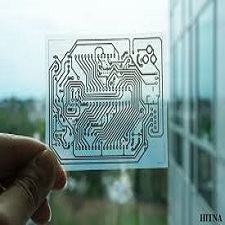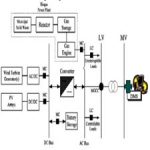توضیحات
ABSTRACT
In this paper a linear circular polarized (CP) Dielectric Resonator Antenna (DRA) array, consist of 3 elements DRA using elliptical resonators, positioned on top of a metallic ground plane exciting through narrow slots is numerically investigated. A Dielectric Image Line (DIL) placed at the back side of the plane is used to excite slots. Antenna characteristics for a single element and linear array including return loss, radiation patterns and antenna gain are presented. To reduce the backward radiation a reflector is placed at the back side of structures. Results show that 5.3% bandwidth is obtained for 3 -dB Axial Ratio (AR) at 10 GHz.
INTRODUCTION
Dielectric Resonator antennas (DRA) is one of the several promising efficient radiating structures which have been proposed for applications at microwave and millimeter-wave frequencies. First DRA was proposed in 1983 and after that in past 2 decades DRAs has been the topic of many researchers due to attractive properties of these type of antennas compare to the conventional antennas such as low loss, low profile and high radiation efficiency. Different shapes of the DRs such as cylindrical, hemispherical, elliptical, pyramidal, rectangular, and triangular have been presented in literature. Feeding methods that are generally used to excite the DRA include: coaxial probe ,microstrip line coupled to a narrow slot , or narrow slot excited by coplanar waveguide. Microstrip-slot coupled excitation of DRs is one of the most common methods for antenna application due to the printed technology which is easy to fabricate and present a good method of impedance matching . But the radiation efficiency of this type is reduced at high frequencies due to the excitation of the surface waves and conductor losses of the feed lines .Dielectric transmission lines such as Dielectric Image Line (DIL) have lower losses at microwave frequencies compare to the conventional transmission lines . In the aperturecoupled microstrip patch antenna fed by a DIL was analyzed.
چکیده
در این مقاله یک آرایه رزوناتور دی الکتریک (DRA) polarized (CP) خطی متشکل از 3 عنصر DRA با استفاده از رزوناتورهای بیضوی قرار دارد که در بالای یک صفحه فلزی زمین هیجان انگیز از طریق اسلات های باریک قرار گرفته است. یک خط تصویر دیالکتریک (DIL) قرار داده شده در قسمت پشتی هواپیما برای تحریک شکاف ها استفاده می شود. ویژگی های آنتن برای یک عنصر تک و آرایه خطی شامل از دست دادن بازگشت، الگوهای تابش و افزایش آنتن ارائه شده است. برای کاهش زاویه عقب یک بازتابنده در قسمت پشتی سازه قرار می گیرد. نتایج نشان می دهد که پهنای باند 5.3٪ برای نسبت عمودی 3dB (AR) در 10 گیگاهرتز به دست می آید.
مقدمه
آنتن های رزوناتور دی الکتریک (DRA) یکی از چندین ساختار پروتئینی موثر است که برای کاربرد در فرکانس های موج مایکروویو و میلیمتر پیشنهاد شده است. اولین DRA در سال 1983 پیشنهاد شد و پس از آن در دو دهه گذشته DRA موضوع بسیاری از محققان به علت ویژگی های جذاب این نوع آنتن ها نسبت به آنتنهای معمولی مانند کمبود، کم مشخصات و بازده پرتوهای پرتابل بود. اشکال مختلف DR مانند استوانه، نیم کره ای، بیضی شکل، هرمیکال، مستطیل شکل و مثلثی در ادبیات ارائه شده است. روش های تغذیه ای که معمولا برای تحریک DRA مورد استفاده قرار می گیرند عبارتند از: پروب کواکسیال، خط میکرواستریپ به یک اسلات باریک و یا اسلات باریک هیجان زده شده توسط موج موج مشترک است. تحریک سیگنال Microstrip-slot DR یکی از رایج ترین روش های کاربرد آنتن به علت تکنولوژی چاپ شده است که به راحتی قابل ساخت است و روش خوبی برای تطبیق امپدانس ارائه می دهد. اما بهره وری تابش این نوع در فرکانس های بالا به علت تحریک امواج سطحی و تلفات هادی از خطوط تغذیه کاهش می یابد. خطوط انتقال دیواری مانند خط دی الکتریک تصویر (DIL) دارای تلفات کمتری در فرکانس های مایکروویو نسبت به انتقال متداول خطوط در آنتن پچ میکروستریپ دیافراگم که توسط DIL تغذیه شده بود، تجزیه و تحلیل شد.
Year: 2010
Publisher : Eighteenth International Energy Conference of Iran
By : E. Mousavi Kejani , Mohammad. H. Neshati
File Information: English Language/ 5 Page / size: 931 KB
سال :1389
ناشر : هجدهمین کنفرانس بین المللی برق ایران
کاری از : E. موسوی کجانی، محمد. H. Neshatti
اطلاعات فایل : زبان انگلیسی / 5 صفحه / حجم : KB 931


![Design Investigation .[taliem.ir]](https://taliem.ir/wp-content/uploads/Design-Investigation-.taliem.ir_.jpg)




![State of Health Estimation.[taliem.ir]](https://taliem.ir/wp-content/uploads/State-of-Health-Estimation.taliem.ir_-150x150.jpg)

نقد و بررسیها
هنوز بررسیای ثبت نشده است.